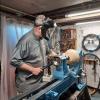Having read positive comments on the forum about the Lyle Jamieson designed 5/8” bowl gouge, made by Doug Thompson, I decided I would give it a try. I have been a satisfied user of Doug’s gouges for many years, so I was familiar with the steel he uses and his cryogenic treatment of it.
For those who are not familiar with this gouge, it is made with the same powdered metal V10 HSS and cryogenic treatment as Doug’s other turning tools, but with Lyle’s flute design and comes with Lyle’s preferred grind for the students he teaches. He says of this grind that it will do all of the commonly used cuts and his students will only need this one gouge grind to do all of those cuts.
The gouge can only be purchased directly from Lyle…
https://lylejamieson.com/product/signature-jamieson-grind-bowl-gouge-thompson-handled/
Here is the grind that came on it…
I measured the nose bevel angle and it was just below 60 °…
Here it is seen from above…
The following photo is an end view of the Jamieson flute profile on the right and the standard Thompson V flute profile on the left...
As you can see, there are some differences between the two flute profiles, which do make a difference in the way each gouge performs, but whatever those differences are neither has a parabolic flute profile, which is how Lyle describes his flute design. Here is an interactive graph of possible parabolic profiles and no matter what value you put into the alpha parameter (other than zero) the sides of the parabola can approach a straight line but never become fully straight…
https://www.desmos.com/calculator/zukjgk9iry
There have been many bowl gouges with parabolic flute profiles since Roy Child (son of Peter Child) designed the original Superflute back in the 1970s that was subsequently manufactured by Henry Taylor.
The difference between the Thompson/Jamieson flutes and the Henry Taylor flute (on right) is very obvious when viewed end-on and side by side…
Both the Thompson and Jamieson gouges have very straight sides. Neither is parabolic, hyperbolic, elliptical, or for that matter catenary. That is not a criticism of those two flute profiles (far from it), but a clarification in terminology.
The flute profile on Doug’s gouge has long been called a V flute and that term is an adequate description and avoids any confusion. Lyle’s flute is also a V with about the same angle between the straight sides (about 60 ° but that was just eyeballing it), but made wider to give a broader vertex (nose) and milled deeper to give a taller flute that is wider at the top. For want of a better description, I would call Lyle’s flute design as ‘whatever’ V to distinguish it from Doug’s… like ‘Big’ V, ‘Large’ V or just LV, as in Lyle’s V, or maybe Super-V… :~}
Having got all of that off my chest, back to looking at other things about the gouge. As you can see in the first end view photo and the following top view photo, there are some serious milling/grinding tracks in the Jamieson gouge, as received, that will need some work on them, as did all of my original Thompsons when they first came. See top view of gouge flute in photo above.
I didn’t bother polishing the tip end of the flute before giving it a test run, but will have to do that at some stage to get the best working edge out of this high vanadium PM steel.
Looking at the photos above you can see that the gouge as received faithfully follows Jerry Glaser’s guidance on mirroring the cutting edge (as seen from above) with the flute profile (as seen from the end view), so that is a good starting point.
One thing to note about the two gouges as seen side by side in the above photo is how deep the Jamieson flute goes down into the bottom of the gouge to achieve the wider flute. As a result, there is less metal left in the gouge which does leave it feeling less solid in the hand than the Thompson standard V.
Lyle states on his website that his gouge has the widest flute of any ⅝” bowl gouge being sold. It measured about 12mm across and is about 1.5mm wider than the standard Thomson 10V and up to 2mm wider than some of my other ⅝” bowl gouge (Thompson 15V - 11mm, Ellsworth Crown - 11mm, VM 11mm, Thompson 10V - 10.5mm, D-Way - 10.8 & 10.6mm, HT - 10.6mm, Woodcut - 9.8mm), so he is probably right with that claim.
Whether there is any benefit from that extra wide flute might become obvious when I give it a test run, which I will report on in my next post.






 Reply With Quote
Reply With Quote





